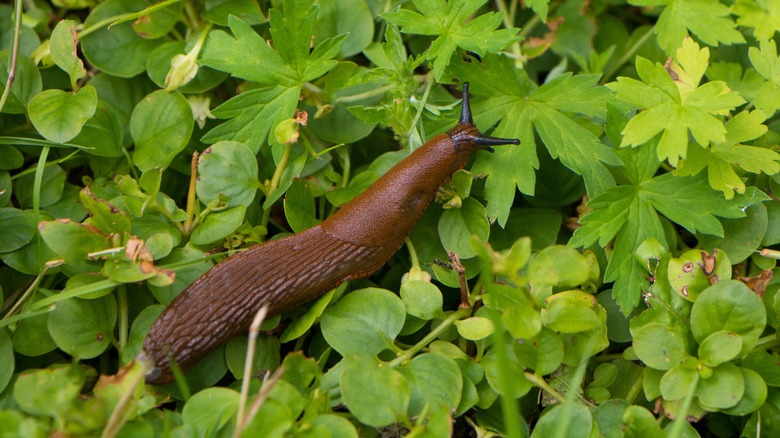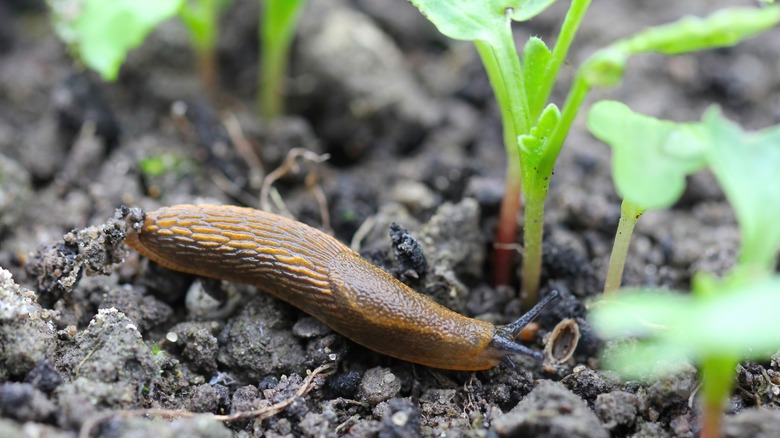How To Identify And Eliminate Slugs Before They Ruin Your Hydrangeas
Our beloved hydrangeas are often the star of our gardens, as these large arrangements boast vivid colors and boisterous clusters of flowers that never fail to draw the eye. But, like many plants, they are susceptible to damage from pests, including slugs. Finding your hydrangeas with missing leaves and gaps in their foliage is a clear sign of just such a problem. You can identify that it is a slug eating away at your hydrangeas and not other pests like caterpillars based on two key details: mucus trails and smooth craters.
Caterpillars typically leave a rougher edge along the spots they nibble on compared to slugs. They also tend to leave visible droppings behind. Slugs will leave smoother spots of damage behind and often leave visible lines of mucus on plants.
If you've identified that slugs are chipping away at your hydrangeas, what do you do now? There are numerous ways to eliminate slugs from your garden and keep them from returning, including lures, home remedies, chemicals, repellant plants, and predators. Hydrangeas are actually not the first meal choice for slugs, as they prefer already dead organic matter. With the proper preventative measures, you'll be able to have your garden in tip-top shape in no time.
Identifying slugs in your garden
Slugs are not only one of the most common garden pests, but some of the most destructive. Although slugs don't have shells like their fellow mollusk snails, they have a protective barrier under their skin, which snails typically don't have. About 40 species of slugs are known in North America, typically sporting a brownish-gray coloration and leaving visible mucus trails in their wake. These mucus trails are the number one sign that slugs are present in your garden, even if you never actually see them. That's because these pests do most of their work throughout the night or after a rainy day, as they hate sunny and dry conditions.
In the northern hemisphere, you'll find that slugs are most active in spring and fall, when they seek shelter in wet, shaded areas around your garden. They are drawn to various food sources, specifically fruits, vegetables, and organic matter like compost. But that doesn't mean your ornamental plants are safe, as slugs will eat whatever they can easily access.
As you search for the slugs harming your hydrangeas, keep an eye out for eggs. Slugs eggs look like tiny, translucent orbs with a gelatinous texture. Slugs often lay their eggs in the same places they take shelter: moist, unlit spaces underneath objects and in the soil.
Removing slugs from your hydrangeas
Eliminating slugs from your garden may seem like a never-ending battle, but there are tricks that make removing them more accessible and manageable. Understanding what a slug finds desirable will be the best knowledge in squashing the problem. These mollusks love to lay low in moist and shaded crevices until it's time to come out and eat. Our gardens have tons of these spaces, such as underneath pots, logs, rocks, and other garden decor. Make an effort to seal off these spots and regularly check areas where slugs may take shelter, removing any you find.
Consider placing lures that will draw the slugs, away from your hydrangeas. Things like decaying fruit will tempt slugs much more than your hydrangeas and will require little effort on your part. Since slugs have minimal protective barriers, they avoid roughly textured paths and don't like highly fragrant plants. Herbs like lavender, rosemary, and sage planted with rocks and other coarse soils often work wonders in repelling slugs.
If you are looking for a more aggressive approach to eradicating slugs, sprinkling them with salt or spraying vinegar on them will quickly kill slugs through dehydration. Similarly, iron phosphate baits can be placed directly in the soil without hurting the garden, yet are poisonous to slugs. Also, consider releasing relatively harmless predators, such as toads, garter snakes, and turtles, into the garden to feed on the slug population.


